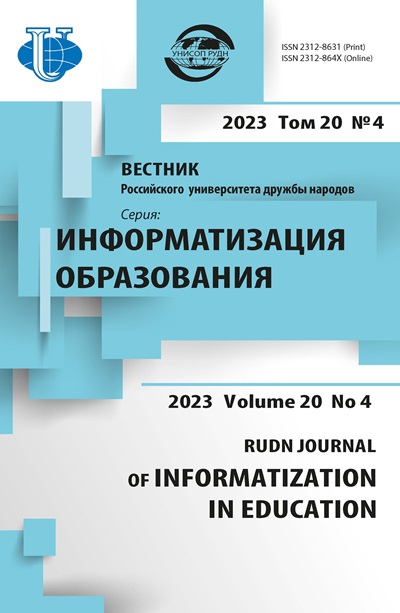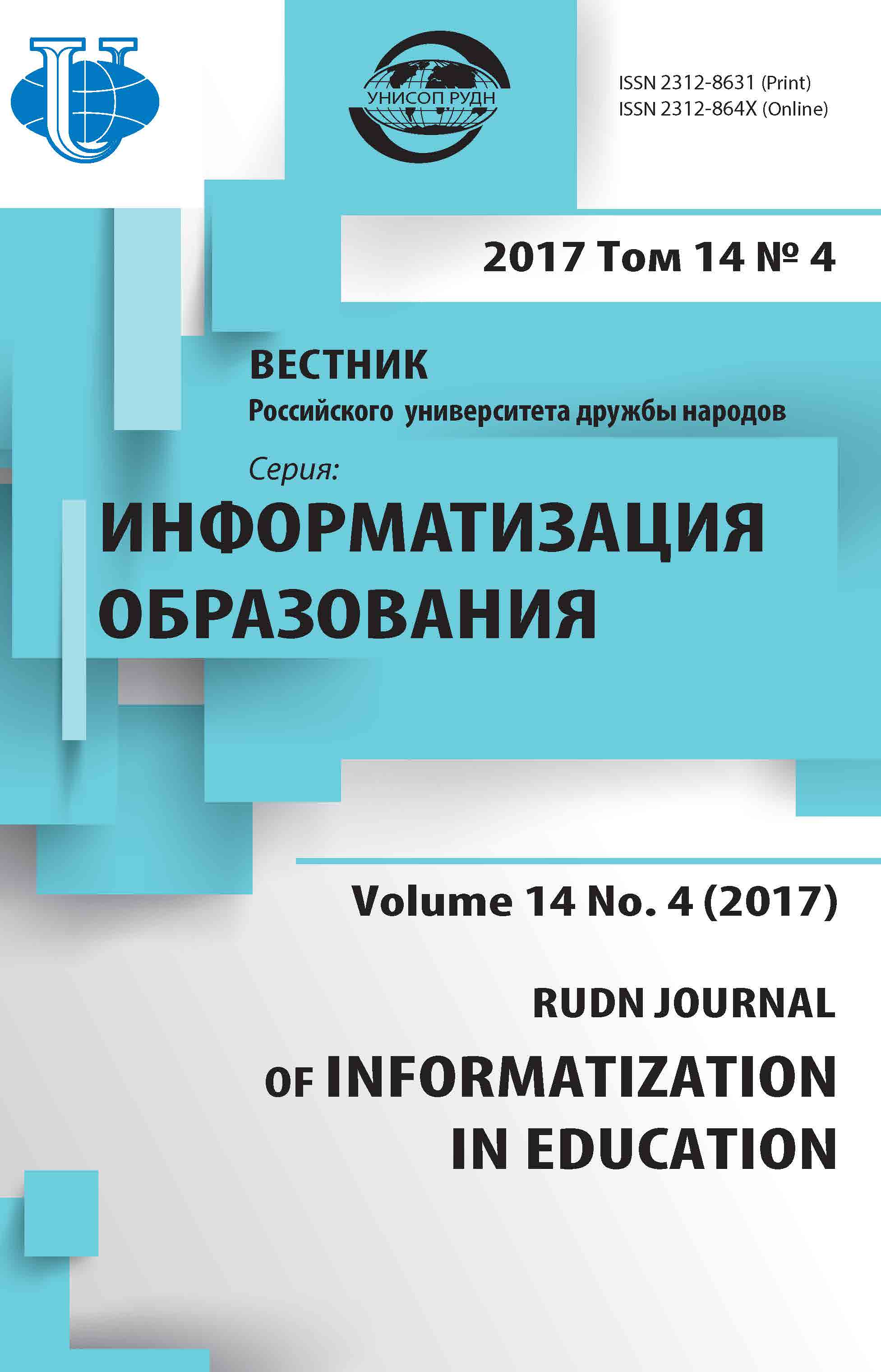THE DEFINITION OF STRUCTURE, TYPES OF TASKSAND DIRECTIONS FOR ELECTRONIC PORTFOLIOSTUDENTS EFFECTIVE USE
- Authors: Bektemesov MA1, Grinshkun VV2, Skiba MA3, Turganbayeva AR1
-
Affiliations:
- Al-Farabi Kazakh National University
- Moscow city pedagogical university
- Narkhoz university
- Issue: Vol 14, No 4 (2017)
- Pages: 406-417
- Section: FORMATION OF INFORMATION EDUCATIONAL MEDIUM
- URL: https://journals.rudn.ru/informatization-education/article/view/17349
- DOI: https://doi.org/10.22363/2312-8631-2017-14-4-406-417
Cite item
Full Text
Abstract
The article deals with the use of electronic portfolio (e-portfolio) for university students anddescribes the features and results of the sociological research conducted with the aim of identifying the most appropriate applications and e-portfolios of graduates. The study identified criteria that allow to define a table of the possible types of components of an electronic portfolio. Taking into account the views of the respondents defined the most actual problems, which solution is possible with the use of properly structured e-portfolio. Such tasks are differentiated depending on the different categories of users portfolio. The article provides guidance to university students for creation of personal electronic portfolio and their subsequent efficient use in the choice of individual educational ways. Discusses the problem of compliance of materials portfolio requirements professional standards relating to professional competencies of graduates. The individuality of the portfolio content which takes into account the psycho ownersis emphasizes. The features and benefits of using portfolio, originally created in electronic form are demonstrates. The article is based on the results of the Kazakhstan project with Russian participation in the use of e-portfolio in universities in different countries.
About the authors
M A Bektemesov
Al-Farabi Kazakh National University
Author for correspondence.
Email: maktagali.bektemessov@kaznu.kz
Bektemesov Maktagali Abdimazhitovich, doctor of physical and mathematical sciences, full professor, dean of mekhanik and mathematical faculty of Al-Farabi Kazakh National University.
al-Farabi str., 71, Almaty, Kazakhstan, 050038V V Grinshkun
Moscow city pedagogical university
Email: vadim@grinshkun.ru
Grinshkun Vadim Valeryevich, doctor of pedagogical sciences, full professor, head of the department of informatization of formation of the Moscow city pedagogical university.
Sheremetyevskaya str., 29, Moscow, Russia, 127521M A Skiba
Narkhoz university
Email: marina.skiba@narxoz.kz
Skiba Marina Aleksandrovna, candidate of pedagogical sciences, associate professor, adviser to the rector of the Narkhoz University (Kazakhstan).
Zhandosov str., 55, Almaty, Kazakhstan, 050035A R Turganbayeva
Al-Farabi Kazakh National University
Email: turalma@mail.ru
Turganbayeva Alma Rymbekovna, candidate of pedagogical sciences, associate professor of informatics of Al-Farabi Kazakh National University.
al-Farabi str., 71, Almaty, Kazakhstan, 050038References
- Vezirov T.G., Kostina E.A. Obrazovatel’nye web-tehnologii v podgotovke bakalavrov i magistrov pedagogicheskogo obrazovanija [Educational web technologies in training of bachelors and masters of pedagogical education]. Vestnik Novosibirskogo gosudarstvennogo pedagogicheskogo universiteta [Bulletin of the Novosibirsk state pedagogical university]. 2016. No. 4 (32). Pp. 39—49.
- Grinshkun V.V. Podgotovka pedagogov k ispol’zovaniju jelektronnyh izdanij i resursov [Training of teachers for use of electronic editions and resources]. Vysshee obrazovanie v Rossii [Higher education in Russia]. 2007. No. 8. Pp. 86—89.
- Grigor’ev S.G., Grinshkun V.V. O razrabotke uchebnika «Informatizacija obrazovanija» [About development of the textbook “Education Informatization”]. Vestnik Moskovskogo gorodskogo pedagogicheskogo universiteta. Serija «Informatika i informatizacija obrazovanija» [Bulletin of the Moscow city pedagogical university. “Informatics and Informatization of Education” series]. 2005. No. 4. Pp. 24—28.
- Nacional’naja ramka kvalifikacij [National frame of qualifications]. URL: http://palata.kz/ uploads/ content/files/Nacional’naja ramka kvalifikacij_2016.pdf
- Poslanie Prezidenta Respubliki Kazahstan N. Nazarbaeva narodu Kazahstana. 31 janvarja 2017 g. «Tret’ja modernizacija Kazahstana: global’naja konkurentosposobnost’» [Message of the President of the Republic of Kazakhstan N. Nazarbayev to the people of Kazakhstan. January 31, 2017. “Third modernization of Kazakhstan: global competitiveness”]: URL: http://www.akorda.kz/ ru/addresses/addresses _of_president/poslanie-prezidenta-respubliki-kazahstan-nnazarbaevanarodu-kazahstana-31-yanvarya-2017-g
- Rostovyh D.A., Smol’nikova I.A., Poljanskaja A.V., Grinshkun V.V. i dr. Podgotovka i professional’naja dejatel’nost’ uchitelej i prepodavatelej informatiki. Kompetentnostnyj podhod [Preparation and professional activity of teachers and teachers of informatics. Competence-based approach]. M.: RGSU, 2010. 212 p.
- Skiba M.A., Bektemesov M.A., Turganbaeva A.R. Fraktal’naja struktura e-portfolio [Fractal structure of an e-portfolio]. Izvestija Jugo-Zapadnogo universiteta. Serija: Upravlenie, vychislitel’naja tehnika i informatika. Medicinskoe priborostroenie [News of the Southwest university. Series: Management, computer facilities and informatics. Medical instrument making]. 2016. No. 1 (18). Pp. 7—15.
- Turganbaeva A.R., Skiba M.A. Tipovaja struktura e-portfolio: osobennosti proektirovanija i napolnenija [Standard structure of an e-portfolio: features of design and filling]. Vestnik Kazahskogo nacional’nogo pedagogicheskogo universiteta imeni Abaja. Serija «Fiziko-matematicheskie nauki» [Bulletin of the Kazakh national pedagogical university name after Abay. Physical and Mathematical Sciences series]. 2015. No. 4 (52). Pp. 207—215.
- Donaldson J. Digital Portfolios in the Age of the Read/Write Webhttp. URL: er.educause.edu/ articles/2012/11/digital-portfolios-in-the-age-of-the-readwrite-web
- Gary R. Brown, Helen L. Chen. Understanding the Evolution of E-Portfolio Practice: Where Do We Go from Here? URL: https://library.educause.edu/resources/2014/1/understanding-theevolution-of-eportfolio-practice-where-do-we-go-from-here
- Europortfolio. European Institute for E-learning (2015): URL: http://www.eife-l.org/about/ europortfolio
- Mary D. Brown. Using Technology // Electronic Portfolios in the K-12 Classroom. URL: http:// www.educationworld.com/a_tech/tech/tech111.shtml
- Mendoza-Calder n, Marco A., Ramirez-Buentello, Joaquin. Hand book of Research one Portfolios. Facilitating Reflection Through ePortfolio at Tecnol gico de Monterrey. Hershey, USA. AliJafari (Ed). 2006. R. 484—493.
- Lane C. The Power of ‘e’: Using e-Portfolios to Build Online Presentation Skills. Innovate. 2007. No. 3 (3). Pp. 98—102.
- Marieke van der Schaaf. Improving workplace-based assessment and feedback 15by an E-portfolio enhanced with learning analytics // Educational Technology Research and Development, April 2017. Vol. 65. Issue 2. Pp. 359—380.
- Balaban I., Mu E., Divjaka B. Development of an electronic Portfolio system success model: An information systems aproach. Computers & Education. 2013. No. 60. Pp. 396—411.
- Dysthe O., Engelsen K.S. Portfolio practices in higher education in Norway in an international perspective: Macro-, meso-and micro-level influences. Assessment and Evaluation in Higher Education. 2011. No. 36 (1). Pp. 63—79.
- Meeus W., Van Petegem, P., Van Looy L. Portfolio in higher education: Time for a clarificatory framework. International Journal of Teaching and Learning in Higher Education. 2006. No. 17 (2). Pp. 127—135.
- Love D., McKean G., Gathercoal P. On implementing web-based portfolios. Educause Quarterly. 2004. No. 25 (2). Pp. 29—37.
- Carpenter R., Apostel S., Hyndman J.O. Developing a model for ePortfolio design: A studio approach // International Journal of ePortfolio. 2012. No. 2 (2). Pp. 163—172.
















